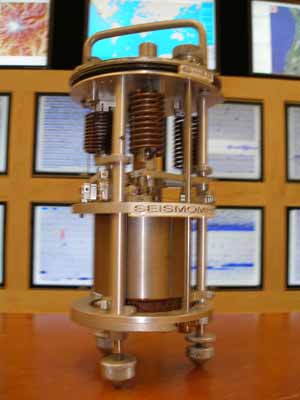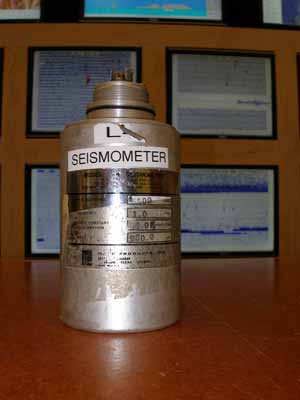Virtual
Tour > Intro > What Causes an EQ > How we locate EQ's > Equipment > Volcanoes > The End!
Seismometers
The equipment used in the field to measure the ground motion
is a device called a seismometer. The Pacific Northwest
Seismograph network has over 200 seismometers in the field
throughtout Washington and Oregon. There are also different
kinds of seismometers out in the field as well. There are
what are called strong motion seismometers used for measuring
earthquakes greater than a 2.0 magnitude earthquake, and
there are short period stations used for measuring smaller
earthquakes and other various motions such as that caused
by a rock fall. These short period stations are so sensitive
that we can read when a person walks by one of them!
Short period stations
 |
Here we can see what
two kinds of short period seismometer look like. The
one on the left is a bigger, heavier, and older device
than the one one the right, however it is hardier
than the one one the right. The one on the right is
smaller and lighter, and is much easier to carry to
a more primitive site, such as in the crater of Mt.
Saint Helens. However, while they both have a different
appearance, the design of the inside and the way each
works is basically the same. |
 |
How They work
|
|
Seismometers measure the amount the
ground shakes by creating an electrical current. The
way this works is that there is a magnet inside the
device that stays locked into place, and on the outside
of the magnet is a copper coil that moves up and down
any time there is movement (this is sometimes reversed,
depending on the instrument).
When this copper coil moves past the magnet, electrical
current is created. The amount of current created
by this motion indicates how much movement there was.
So essentually we are measuring the amount of current
being created. |
Strong motion stations
|
|
|
Strong motion stations
are used to detect the stronger earthquakes that we
might feel or that could cause damage. With the short
period stations, there is a limited range of motion
that the magnets can travel, only allowing us to measure
up to a magnitude 2.0 earthquake. With a strong motion
station however, we can accurately measure the largest
potential earthquake for the Pacific Northwest, and
that is up to just over a magnitude 9.0! These stations
can give us more accurate data on larger earthquakes,
data that was once cut off. |
Installation
When we are installing these devices out in
the field, we typically use a couple of different methods,
depending on what it is we are trying to measure. One meathod
is to dig a hole about four feet deep or so and about two
feet in diameter. We then pour concrete into the bottom
of the hole and allow it to dry. We then place the instrument
onto the concrete and make the instrument as perfectly level
as possible. We then hook up the instrument to its power
supply and connect the data line and run the wires via conduits
to the surface. The instrument is covered up with the dirt
and the area is restored to like it was before we were there.
The other way of installing an instrument
is by putting the instrument above ground. With this method
we just pour the concrete in some sort of base, allow it
to dry, and then put the instrument on that. The instrument
is then protected by a casing which we place over it.
To learn more about seismometers, click here
Next>>>
|
|